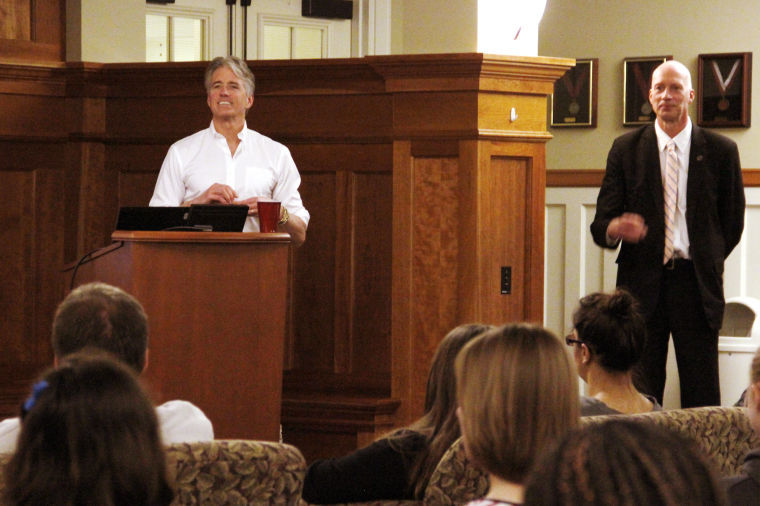Taking out rabies one step at a time
Director Guy Palmer of the Paul G. Allen School of Global Animal Health speaks on the challenges of improving global health in the Honors Lounge, Monday, March 10.
March 11, 2014
To Guy Palmer, the director of the Paul G. Allen School for Global Animal Health, eliminating rabies is an attainable feat.
Palmer addressed students and faculty in the Honors Lounge in the fifth and final Honors lecture of the semester. He discussed how the disease connects animals to humans in his lecture titled “Improving Human Health by Intervention at the Animal-Human Interface.”
Palmer, who works to control rabies, said the U.S. has had more endemic rabies than any country in the world, yet there are almost no cases of humans contracting the disease. This is not the case in other parts of the world, including southeast Asia and sub-Saharan Africa.
“You’ll hear a lot more about bird flu in the paper than you will around rabies, and that’s because it’s someone else’s problem,” he said.
This is because 99 percent of rabies cases are transmitted by dogs, not wildlife, due to the close relationship between dogs and humans, Palmer said. He said the U.S. has eradicated rabies in dogs.
However, in less developed areas like Tanzania, where Palmer works, vaccinating all the dogs is not a realistic feat. For that reason scientists had to document the rate at which the disease spread in order to discover what percentage of dogs needed vaccination.
“When I’m in the infectious phase, how many individuals will I transmit to before I die or stop spreading the virus?” he explained.
Palmer’s team found that every infected dog tended to bite 1.2 other dogs before dying of the disease. This means by vaccinating between 60 and 70 percent of the population, the chance that a rabid dog would bite a vaccinated dog would increase, and as a result the spread would slow and the disease would die out, he said.
“If you get 70 percent of vaccination coverage, you really completely control rabies in that environment,” he said. “We can get the disease out of the area (at 70 percent). The question is, can we keep it out of the area?”
If the rabies campaign is stopped, the disease will creep back into the population since it has not been completely eradicated, he said. To address this, Palmer’s project in Tanzania has developed a ‘belt’ solution.
This solution systematically expands the vaccinated areas, starting in one central location and working outward, he said. Especially if started from multiple locations that spread toward one another, this method can keep areas rabies-free by preventing the disease in neighboring areas.
“You’ll basically begin to squeeze out the rabies,” Palmer said.
Senior animal science major Courtney Roller found it interesting to learn what percentage of a population ought to be vaccinated and how that number can be determined.
“It’s really interesting how there’s that threshold in rabies treatment,” she said.
Palmer emphasized the importance of viewing health as a global issue.
“Global health is not just looking at problems and diseases in other parts of the world,” he said. “It’s really about looking at what we all have in common.”
Junior zoology major Travis King expressed interest in the interconnectedness of the issue, which he said spans a variety of disciplines and weighs heavily on individual steps.
“It gave a different perspective on how you look at things,” King said.
Palmer said if students could take away one thing from his talk, it would be a clearer definition of ‘global health.’
“We often tend to think of global health as, ‘It’s all about curing malaria. It’s all about curing TB,’” he said. It’s about everything that makes individuals, and through individuals, families and communities much healthier.”





















